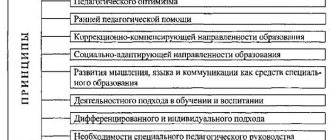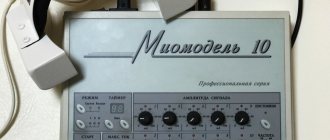What is FGR in children? Treatment of cervical cancer in Russia, Saratov
SRD is a delay in speech development in children , a delay in speech development. SRD is characterized by a lag in speech development from the age norm.
Sarklinik provides treatment for cerebral cancer in Russia , treatment for cerebral cancer in Saratov .
New methods of treating mental retardation activate the speech centers of the brain, improve speech development, improve diction, increase vocabulary (the number of words used), and improve the acquisition of new speech skills. The doctor will tell you what the diagnosis of mental retardation , how treatment is carried out, diagnosis, correction of mental retardation , what to do, how to treat mental retardation at any age (at 2 years old, at 3 years old, at 4 years old, at 5 years old, at 6 years old, at 7 years and older), how to cure mental retardation, whether classes with children are needed if the child has a delay in speech development , why speech delay , speech disorders , as well as how to restore and improve speech development, what is general speech underdevelopment (GSD) , alalia, alexia (dyslexia), aphasia. If your baby is different from others, be sure to visit a doctor. An experienced specialist will see developmental abnormalities in the child, prescribe an examination and provide the necessary therapy.
Delays of mental and speech development (ZPR, ZRR), general speech underdevelopment (GSD)
The problem of mental development delays (MDD), speech development delays (SSD), and general speech underdevelopment (GSD) is closely related to the problem of alalia.
The terms delayed mental and speech development - “ZPR” and “ZRD” - as speech diagnoses have become quite widely used in practice.
At the same time, diagnoses of mental and speech development delays are considered more appropriate in relation to young children (up to 5 years), when there is hope for the further development of systems that slow down the maturation of the psyche and speech function in a natural way.
It is understood that children with mental retardation and developmental disabilities will master the necessary cognitive (cognitive) and speech skills in the same way as normal children, only at a later and shorter time. As a rule, such children are offered a larger volume of stimuli for development than normal children.
They are presented in an exaggeratedly expressive form. In this case, the calculation is made on spontaneous compensatory mechanisms, similar to those that ensure the development of a healthy child.
In pedagogy, children with mental retardation are mainly identified in high school and junior school age. At school, they form groups of underperforming students who have “specific learning difficulties,” “slow learners,” etc.
The reasons for the lag of this contingent of children are most often:
– pedagogical neglect;
– functional immaturity of the central nervous system;
– organic damage to the central nervous system.
In the literature there are various designations for children with mental retardation: “mild forms of mental retardation”, “borderline morons”, “controversial morons”, “borderline mental retardation”.
Thus, there is a tendency to bring mental retardation closer to mental retardation, which indicates a blurring of the boundaries between them.
Many researchers find that children with mental retardation have underdevelopment of auditory, visual, and motor functions, optical-spatial disorders, insufficiency of tactile perception, etc.
Especially often it is indicated that there is a slowness in the reception and processing of sensory information, a decrease in memory and attention.
Almost all works indicate that such children (with mental retardation) are lagging behind in speech development (in all its parameters, although the accents of different children fall on different aspects of speech). Their lack of curiosity is also pointed out.
The above explains the great difficulty of distinguishing between mental retardation and mental retardation. However, almost all researchers agree that children with mental retardation, unlike mental retardation, are capable of certain types of abstract (abstract) thinking. In addition, they have a tendency to solve various problems with the help of semantic supports.
The peculiarities of brain activity in children with mental retardation boil down to the fact that with various forms of speech development disorders they may suffer from:
– deep structures of the brain, which have an inhibitory upward influence on its cortex and slow down its development;
– secondary cortical fields that prevent the timely formation of the functions of speech auditory gnosis and articulatory praxis;
– pathways between individual areas of the cerebral cortex, ensuring the formation of the necessary associative connections.
The main feature of such damage is their partiality (incompleteness, selectivity), in contrast to oligophrenia, in which the pathological process covers almost the entire brain.
The presence of “healthy” areas of the brain in children with “delays” allows them to acquire a volume of knowledge sufficient to include (at least partially) the tertiary fields of the cerebral cortex in their work. This explains the fact that children with mental retardation have access to certain mental operations of a symbolic nature.
In some forms of mental retardation and mental retardation, brain damage may be completely absent, giving way to unfavorable social factors (pedagogical neglect).
In contrast to the terms ZPR and ZRR, the term ONR is not recognized by all researchers of child speech pathology and practitioners.
They prefer to use the traditional term “alalia,” which also implies a general (systemic) lack of development or underdevelopment of speech. They understand the term OHP as replacing the traditional term alalia.
The reason for this is that there has been increased attention to speechless children from teachers and child psychologists.
It was introduced by R.E. Levina within the framework of the psychological and pedagogical concept of speech disorders in children and, accordingly, has a different, namely psychological and pedagogical meaning. The term “ONR” is more acceptable and understandable to people in the teaching community, and is convenient when recruiting kindergarten groups.
Note:
Currently, in practical defectology, and in particular in speech therapy, a rather complicated situation has developed regarding the traditional terms “alalia”, “dysarthria”, “logoneurosis”, “dyslalia”.
In connection with the division of specialized speech therapy services into those belonging to the Department of Health and Education, guidelines and regulations are issued prohibiting speech therapists working in the field of education from using them, citing the fact that they are of medical origin.
This situation seems unacceptable. There is an urgent need to unify terminology related to speech pathology, which would be used by specialists regardless of their place of work.
This does not mean, however, that psychological and pedagogical audiences cannot use terms that are more understandable to teachers.
But in this case, psychological and pedagogical terminology will be of a private nature, without pretending to abolish the traditional names of common speech disorders in children.
Thus, the term “ONR” is a pedagogical designation of the clinical term “alalia,” which some authors object to, pointing to the prefix “a” as denoting a complete absence of speech, and believe that the diagnosis “alalia” can only be made if if the child does not have it at all.
At the same time, the prefix “a” in the term alalia is as conditional as the prefix “a” in the term “aphasia,” in which, as is known, speech in patients is not always completely absent.
Moreover, aphasia is called both severe speech disorders, up to complete inability to speak, and mild ones, if they have the same etiology and pathogenesis. Thus, the prefix “a” should not be an obstacle to the diagnosis of “alalia”.
The main condition here should be the presence in the structure of the defect of difficulties in using the means of language.
In other words, from the standpoint of neuropsychology and neurolinguistics, with alalia there should be a deficiency in the functioning of the tertiary fields of the cortex, just as the main condition for the diagnosis of “dysarthria” should be a deficiency in the innervation (nervous supply) of the articulatory muscles from the stem and subcortical structures of the brain .
Delayed psycho-speech development, psycho-speech development, mental retardation in children
Delayed psycho-speech development in children , delayed psycho-speech development , mental retardation are increasingly common in children in recent years. At the first appointment, the doctor will tell you how to identify a child with mental retardation, how to diagnose mental retardation, what is the diagnosis of mental retardation in children, what forms, types, classification, definition of mental retardation, developmental features of children with mental retardation, personality traits of the child, how correction is carried out, psychocorrection, correctional work, treatment of mental retardation, treatment of delayed psycho-speech development in Saratov , are classes needed, osteopath, methods, program, training of children ( children with mental retardation ), which includes general characteristics, examination of children, development of children with mental retardation, examination of children, diagnostics ( including neurosonography), differential diagnosis, psychodiagnostics, is disability registered, what kind of prevention is there, what are the behavioral characteristics of children with mental retardation, how to cure mental retardation of cerebral-organic origin? How to teach children with developmental delays, is mental retardation treated ? Preschoolers (kindergarteners, kindergarten, kindergarten, preschool age, preschool children, preschoolers, schoolchildren), primary schoolchildren (school, gymnasium, lyceum) are currently constantly exposed to great stress, emotional, and mental stress. Increased load can sometimes have a negative impact on the child’s central nervous system, the emotional sphere, sensory development, social development suffer, mental retardation is observed, thinking, cognitive sphere, memory development suffers, and mental development lags. More often, mental retardation of cerebral organic origin is observed; there is also retardation of somatic origin, tempo delay of psychological, psychoemotional, mental, emotional, physical, statomotor, motor development, stages of development, including constitutional, statokinetic origin.
Mental retardation with speech underdevelopment
2.4. Intellectual deficiency with general speech underdevelopment - alalia syndromes. Synonyms: speech underdevelopment, alalia, congenital aphasia, developmental aphasia, constitutional delay in speech development. More common is underdevelopment of expressive speech or motor alalia. In early childhood, such patients experience a lack of babbling and a sharp delay in speech reactions. The first words appear at the age of 2-3 years, sometimes later. Phrasal speech appears by the age of 5–6 years and consists of sentences of 2–3 words. Gross violations of all aspects of speech are detected: poverty of vocabulary, disorders of sound pronunciation, distortion of word structure and grammatical design of phrases. There is a pronounced gap between the expressive and impressive sides of speech: when understanding everyday phrases, the child has almost no independent speech. At preschool age, children exhibit a certain intellectual productivity, which is dissociated with an almost complete absence of active speech. They are interested in games, have a good grasp of everyday life, show fairly differentiated emotions and affections, and master the skills of neatness and self-service. At primary school age, expressive speech disorders continue to prevail; with the beginning of education, speech and writing disorders are revealed: children slowly learn to write letters, confuse and poorly remember similar-sounding phonemes, have difficulty writing endings, unstressed vowels, words with a combination of consonants, and in word agreement. and writing prepositions. With age, speech disorders gradually smooth out, the vocabulary becomes somewhat enriched, and the number of phonetic and grammatical errors in oral speech decreases. But even in the senior classes of a specialized school, there are still defects in pronunciation, grammatical structure of oral and written speech, and in understanding and writing complex logical and grammatical structures. Cognitive deficit is expressed in a poor supply of knowledge about the environment, delayed formation of concepts about the shape, size of objects, time, counting operations, the inability to retell what was heard, read, to convey in a coherent form one’s impressions of what happened, as well as a decrease in the ability for abstract thinking, closely related with inner speech. The concrete-figurative type of thinking predominates, the abilities for generalization and abstraction are poorly developed. School failure concerns both humanities and exact disciplines. During testing, patients cope worse with tasks requiring active speech. The main difference from oligophrenia is, according to L. S. Vygotsky (1956), a higher level of “practical-effective” and “wordless” visual-figurative thinking. At the same time, disturbances in the pace, direction and switchability of mental processes, disorders of active attention and memory, personal immaturity in the form of insufficient understanding of social requirements, and increased inhibition when presented with speech tasks are revealed. Another disorder is developmental expressive language disorder. Such children under 1-1.5 years old do not respond to speech addressed to them, do not understand the meaning of simple requests and instructions addressed to them. Parents of such children may long consider them deaf-mute, although the children’s hearing is usually normal. Intellectual development disorders in this speech development disorder occur constantly and can be more pronounced than in cases of expressive speech development disorder. (For more information about developmental disorders of different aspects of speech, see the tables.)
Return to Contents
What is PVD in children? Treatment of ZPRR in Saratov, Russia
ZPRD is a delay in psycho-speech development in children ( delayed psycho-speech development ). With ZPRD, both mental development delay and speech development delay are observed. Sarklinik provides treatment for cervical cancer in Russia , treatment for cervical cancer in Saratov . Diagnosis, correction, overcoming, complex treatment of mental retardation and developmental rates activate both the mental and speech development of the child. ZNPRR is a delay in neuropsychic-speech development, or a delay in neuropsychic development.
At the first consultation, the doctor will tell you what the diagnosis of SPR in children is, autism, what are the signs of SPR, symptoms of SPR, how treatment for SPR is carried out in Saratov, Moscow, St. Petersburg, China, in Russia, how to cure SPR with autistic traits , in including ZPRR on a residual organic background .
Causes and symptoms of developmental delay
Delayed speech development and/or psychological development, causes:
- Characteristics of the child or the educational process.
- Neurological diseases, disorders.
Delayed speech in a child and/or psychological development, symptoms:
- The child does not show interest in educational activities.
- Hot temper or unnatural cheerfulness.
- Poor vocabulary.
- Fatigue, moodiness.
- Emotional reaction to bright lights, loud music.
- Poor progress in learning.
What is a missile defense system? Mental retardation in children: treatment of mental development in Russia, in Saratov
SSD is a mental retardation in children , boys and girls in Russia, in Saratov. Sarklinik provides treatment for mental retardation in Saratov, treatment of mental retardation in children , treatment of mental retardation, treatment of debility, treatment of imbecility, treatment of idiocy, treatment of dementia, treatment of mental retardation. Effective methods activate the brain, central nervous system, improve mental development, intellectual development, thinking, memory, speech, emotions, motivation, movements, skills, learning. Inhibited (torpid) and excitable (eretic) children are treated.
What is the difference between ZPR and UO?
- The main difference between mental retardation and mental retardation is the former’s ability to be reversible, while mental retardation cannot be cured.
- ZPR is characterized by partial manifestations, that is, deviations from the norm in a child are not observed in all areas, but only in some aspects of his life. Manifestations of MR are total, and the difference between the baby and his peers is observed in almost everything.
- Children diagnosed with mental retardation demonstrate new skills in leaps and bounds. As a result of irreversible damage to the cerebral cortex, representatives of the UO are distinguished by hierarchical development.
Differences demonstrated during learning
There are also differences between the two diagnoses in the area of cognitive abilities. Thus, children with mental retardation, with proper attention from their parents, can show a fairly rapid development of the ability to abstract from a particular situation, independently analyze something, compare objects, process information, and generalize.
Children diagnosed with mental retardation have reduced cognitive abilities that are almost impossible to improve. They do not have the skill to establish cause-and-effect relationships; they cannot make comparisons or generalize existing facts.
Mental retardation and mental retardation (differences, table)
| ZPR | Mental retardation |
| The speed and level of thinking can be corrected with the right approach | No adjustments help speed up the development process |
| There is a possible negative impact on intelligence: hearing, vision, coordination, as well as level of attention and perception | There is an impact on the thought process |
| Great importance is given to play activities, with the help of which the child’s condition can be improved; he himself willingly joins in the gameplay | Shows absolute indifference to almost any game |
| Highly emotional, able to concentrate on completing the task at hand | The emotional sphere is poorly developed; performing a specific task is accompanied by frequent distractions for the child |
| Capable of mastering fine art skills | Show no interest or ability in the visual arts. When carrying out the learning process, in rare cases they can draw simple figures, arbitrary lines, chaotically written letters |
| Appearance and behavior characteristics are not dysplastic | May be characterized by severe dysplasticity: disturbances in body proportions, strabismus, severe awkwardness, the presence of six fingers, a noticeable slowdown in speech, stuttering and other defects |
| Do not have pronounced manifestations in their neurological status | Asymmetry of the face and tongue may be noted; A venous network may be visible in some areas of the face |
Causes of development of mental retardation, mental retardation, mental retardation, mental retardation, delayed speech development, psycho-speech development
The causes of development of mental retardation, mental retardation, mental retardation, mental retardation, mental retardation , mental retardation , and delayed psycho-speech development of a child are varied. Why do children experience developmental delays? What is the etiology of developmental delay? Let us dwell on the main factors that provoke developmental delays in children.
- Perinatal encephalopathy (PEP).
- Birth trauma, birth injuries of newborns.
- Increased intracranial pressure, intracranial hypertension, hypertension syndrome.
- Vaccination, vaccinations, vaccination complications, vaccination complications, vaccination complications.
- Traumatic brain injuries.
- Intrauterine fetal hypoxia IVGP, VUGP (deterioration of placental blood circulation, deficiency, lack of oxygen during pregnancy, during childbirth, green original stool, meconium in amniotic fluid, signs - change in fetal heart rate, green amniotic fluid), asphyxia.
- Caesarean section (and a history of cesarean section - in the past, during previous births).
- Intrauterine infection (intrauterine infections).
- Threat of miscarriage.
- Weak labor.
- Fast, rapid birth.
- Low newborn Apgar score (low scores - Apgar scale).
- HDN, hemolytic disease of the newborn, hemolytic jaundice of the newborn (jaundice).
- Anemia of pregnant women (grades 1, 2, 3), anemia in the mother during pregnancy.
- Gestosis of pregnant women in the first (1st) or second (2nd) half of pregnancy, toxicosis (preeclampsia, toxicosis).
- Prematurity, postmaturity (premature baby, post-term baby), premature birth, premature rupture of amniotic fluid.
- Pathology of the pregnant mother (hypotension - decreased, low blood pressure, hypertension - increased, high blood pressure, collagenosis, diabetes mellitus, ketoacidosis, high physical activity, prolonged position of the pregnant woman on her back, decreased or worsened uterine blood flow, chronic bronchitis, STIs, cervicitis, colpitis , genital tract infections, sexually transmitted diseases / chlamydia, gonorrhea, mycoplasmosis, ureaplasmosis, trichomoniasis, trichomoniasis, etc. /, heart disease, BA - bronchial asthma, ).
- Absence of fetal heart rate variability, prolonged late low-amplitude decelerations when performing CTG of a pregnant woman, a positive non-reactive result when conducting a test such as a stress test with CTG (cardiotocography), or less than 7 points with a non-stress test.
- Oligohydramnios, polyhydramnios, changes in the volume of amniotic fluid during pregnancy.
- Multiple pregnancy.
- Intrauterine growth retardation.
- Placenta previa.
- Isthmic-cervical insufficiency.
- Pathology of the placenta and umbilical cord during pregnancy (poor Doppler).
- CDF, congenital malformations.
- Hormonal disorders, endocrine diseases of the mother.
Basic clinical issues and taxonomy of mental retardation
The clinical study of mental retardation presents certain difficulties, since in these cases we are talking about structural signs and patterns of dynamics not of a disease state, but of developmental anomalies - disorders of mental ontogenesis.
If the disease is the indisputable competence of the clinician, then anomaly of mental development is largely an area of special psychology that studies the deformation of normal mental functions and mental development in conditions of pathology. Nevertheless, the close connection between psychopathological painful symptoms and mental development disorders contributes to the fact that various mental development anomalies have always been the object of study not only by psychologists and teachers, but also by psychiatrists.
Naturally, the problem of the relationship between the dynamics of painful disorders and developmental anomalies is of particular importance in childhood, since due to the immaturity of the brain, almost any more or less long-term pathogenic influence leads to deviations in mental development. Depending on the nature, localization, degree of prevalence of the process, time of exposure to harm, conditions of education and training, this developmental anomaly has its own modality (various types of developmental disorders of the intellect, emotional sphere, motor skills, vision, hearing, etc.), as well as the or another degree of expression.
In cases of early exposure to harm, the severity of developmental abnormalities may overlap the severity of disease-related encephalopathic disorders, as is the case with oligophrenia and early childhood schizophrenia. V.V. Kovalev (1979), in the taxonomy of residual neuropsychic disorders in childhood, distinguishes “predominantly dysontogenetic forms” (developmental anomalies, in the terminology of domestic defectology), “predominantly encephalopathic”, in which the symptoms of the disease predominate rather than developmental disorders, and “mixed - dysontogenetic-encephalopathic."
A developmental anomaly, qualified as mental retardation , occurs much more often than other, more severe disorders of mental ontogenesis.
The problem of mental retardation is one of the most pressing not only in defectology, but also in general pedagogy, since it is closely related to the problem of school failure. The number of primary school students experiencing persistent learning difficulties ranges from 5 to 11% (RL Masland, 1969; M.S. Pevzner, 1972; V.I. Lubovsky, 1972, etc.). These children became the object of study by defectologists, psychologists, teachers, and doctors.
Research conducted in 1972-1973 The Research Institute of Defectology of the Academy of Pedagogical Sciences of the USSR in a number of cities and rural areas of the USSR (Moscow, Irkutsk region, Lithuania, Armenia) identified 589 (11.6%) children with learning difficulties among 5076 primary school students in public schools. As the results of a comprehensive (clinical, psychological, speech therapy and audiological) study showed, less than 1/3 of them (30.6%) suffered from a mild degree of mental retardation. 19% were made up of a combined group that included children with primary disorders of speech, visual and auditory afferentation, the musculoskeletal system, as well as children whose learning difficulties were associated with behavioral disorders.
50.4% of underachieving students (or 5.8% of all primary school students) were diagnosed with mental retardation, because according to a number of parameters of their intellectual sphere and emotional-volitional characteristics (lack of general stock of knowledge about the environment, limited ideas necessary for mastering school subjects, immaturity of thinking, unformed educational interests and the predominance of gaming) they were at an earlier age stage of development. At the same time, sufficient intelligence within the limits of existing knowledge and the ability to accept help testified against the oligophrenic structure of the defect.
The attention of clinicians was primarily drawn to the infantile traits of the psyche of many of these children: their emotional immaturity, weak motivation for behavior, the playful nature of their interests, and their inability to exert volition.
Special studies have shown the clinical variety of variants of mental infantilism observed in these children. M.S. Pevzner (1972) proposed a classification of these conditions, in which infantilism appeared both in its pure form (“uncomplicated psychophysical and mental infantilism”) and in the form of variants complicated by underdevelopment of cognitive activity and speech. T. A. Vlasova, M.S. Pevzner (1973) identified “secondary” mental retardation, caused by impaired cognitive activity and performance due to persistent cerebrovascular disease - increased exhaustion of mental functions. The etiological factors were more often mild cerebral damage, metabolic and trophic disorders that act in the early stages of ontogenesis. In the pathogenesis of infantilism, the leading role was given to the slowing down of the rate of maturation of the frontal and frontal-diencephalic systems of the brain, which normally ensure both the level of personality development and the formation of purposeful activity.
In the classification proposed by M.S. Pevzner and T.A. Vlasova: 1) mental retardation associated with mental and psychophysical infantilism; 2) mental retardation caused by long-term cerebrovascular disease - lays down the basic principles of the clinical approach to understanding the mechanisms of development of mental retardation: the possibility of its occurrence both due to a slowdown in the maturation of the emotional-volitional sphere, and due to neurodynamic disorders that inhibit the development of cognitive activity.
The difference in pathogenetic mechanisms also determined the difference in prognosis. Mental retardation in the form of uncomplicated mental infantilism was regarded as prognostically more favorable, mostly not requiring special teaching methods. With a predominance of pronounced neurodynamic, primarily persistent cerebrasthenic disorders, mental retardation turned out to be more persistent and often required not only psychological and pedagogical correction, but also therapeutic measures.
As mentioned above, the results of the research provided an incentive for the organization of special classes and schools for children with mental retardation.
The experience of these schools has shown that with special forms and methods of teaching, a slight increase in the duration of the program, a gentle regimen, and supportive drug therapy with restorative, sedative and stimulant drugs, approximately half of these children, after studying in the primary grades of a special school, can be transferred to the fourth grade of a public school . The rest of the students must continue their education in special conditions at these schools.
Generalization of data obtained in recent years in the clinical laboratory of the Research Institute of Defectology during a comprehensive clinical, psychological and pedagogical study of students in these schools, as well as other children who do not perform well in the lower grades of a public school, made it possible to clarify the clinical and psychological structure of various types of mental retardation, a number of issues of its clinical systematics, criteria for distinguishing from oligophrenia, the relative role of biological and social factors in the formation of its various types.
1 forward → show on one page
Pathogenesis of ZRR, ZPRR, ZNPRR, ZPR, ZPRR, why and how developmental delay occurs
Often the pathogenesis of RRR, VMR, delays in speech, psycho-speech, psycho-speech development is associated with oxygen starvation of brain cells during intrauterine development. As a result of intrauterine hypoxia, neurons of the brain are affected, and the function of those parts of the central nervous system (central nervous system) for which they were functionally responsible is lost. When carrying out vaccinations (vaccinations), autoimmune reactions can be triggered, which are accompanied by death and destruction of nerve cells. By the way, the launch of autoimmune reactions can be accompanied by the development of severe pathology, even the development of cerebral palsy (cerebral palsy). Therefore, in case of any neurological changes in a child or perinatal encephalopathy, it may be necessary to temporarily refrain from vaccinations until the child’s neurological status is completely normalized. The neurological status of the child includes complaints, anamnesis, general appearance, postures, movements, behavior, study of cranial nerves, sensitivity, motor function, reflexes, meningeal syndromes, additional examination data, speech vocabulary.
Differential diagnosis of mental retardation and acute renal failure
Mental retardation (MDD) is a common form of mental pathology in children and a form of mental disorders. The main signs of this pathology are a stock of knowledge that does not correspond to the child’s age, low cognitive activity, insufficient regulation of behavior and voluntary activity. The ability to receive and process perceptual information in such children is lower than in normally developing children.
The function of voluntary attention, memory and other higher mental functions is insufficient and is observed in the majority of children with mental retardation. One group of children is characterized by intellectual disability, another group has emotional and volitional disorders such as mental infantilism. With mental retardation, in contrast to mental retardation, there is a pronounced uneven development of higher mental functions.
Since the potential capabilities of higher forms of cognitive activity are preserved, children with mental retardation are able to use help and independently transfer it to new tasks, which mentally retarded children cannot do. However, writing, reading and counting in children with mental retardation have the same errors as in mentally retarded children, although there are also qualitative differences. Children with mental retardation, having poor reading technique, try to understand what is written and, if necessary, read it a second time.
Calligraphy skills in writing are unsatisfactory and sloppy, and experts believe that this may be due to underdevelopment of motor skills and spatial perception; sound analysis is also difficult for them. Difficulties in mathematics are observed in mastering the composition of a number, passing through ten, with indirect questions in solving problems.
Taking this into account, in differentiated diagnostics, the examination of children must be carried out in the form of a teaching experiment.
Also of decisive importance is a comprehensive examination, including a clinical analysis of impaired mental and speech development, a psychological study of the child and additional research methods, for example, electroencephalography.
Differential diagnosis is assisted by analysis of the dynamics of the child’s mental development.
As for general speech underdevelopment (GSD), this is understood as a violation of the formation of all components of the speech system, while hearing and intelligence are preserved.
With general underdevelopment of speech, difficulties are caused by those tasks that require the direct participation of speech. In construction tasks, where a verbal response is not required, less assistance is required in the formation of generalized methods of action.
Emotional reactions in children with ODD are more subtle compared to mentally retarded children; they evaluate their speech impairment critically and quite consciously avoid verbal responses in tasks, showing interest and intelligence when performing them.
The activities of children with special needs are more focused and controlled. If underdevelopment of speech is observed with hydrocephalus, then the differentiated diagnosis of OHP becomes significantly more difficult, and special difficulties arise when oligophrenia is complicated by alalic and dysarthric disorders.
Note 2
Differential diagnosis of children with OHP requires a comprehensive clinical, psychological and pedagogical examination.
Symptoms, signs, manifestations of mental retardation, mental retardation, mental retardation, mental retardation, speech delay, psycho-speech development
What are the symptoms, signs, manifestations of mental retardation, mental retardation, mental retardation, mental retardation, mental retardation, delayed speech development? The developmental delay clinic is clearly visible. If the child does not hold his head up in time, does not turn, does not roll over, the child does not sit , does not stand, does not walk, then this is a reason to immediately consult a doctor. Often in this case, a pediatric neurologist , neurologist , microneurologist , neonatologist prescribe medications, medicines, medications, tablets, injections, massage, electrophoresis, baths, infusions, tinctures, decoctions, mixtures, but the effect is, unfortunately, insignificant.
Diagnostic features
Only a specialist can diagnose the presence of a particular disease in a child, therefore, when the first thoughts appear that something is wrong with the baby, you should immediately. In most cases, when there is really no cause for concern, a consultation with an experienced pediatrician is sufficient.
However, in order to be completely sure, it is best to show the child to a pediatric neurologist or neurologist.
In some cases, it is necessary to contact several specialists at once: a neonatologist, neurologist, defectologist, neurosurgeon, speech therapist, psychologist or psychotherapist.
The specialist will conduct a thorough in-person examination, review your medical history and prescribe a series of examinations to make an accurate diagnosis. These may include the following:
- CT;
- MRI;
- Dopplerography of cerebral vessels;
- electroencephalography, etc.
With the help of tests, the functioning of the organs of hearing, vision, thinking abilities, concentration, and fine motor skills will be assessed. The specialist may also be interested in whether there were cases of similar diseases in the family, whether any of the relatives suffered from genetic diseases, how the mother’s pregnancy proceeded, etc.
What to do if the defectologist and speech therapist do not help the child?
A speech pathologist and speech therapist are working with the child, but there are no results. What to do, how to improve the psycho-speech, speech, mental, motor, psycho-speech, psychomotor development of a child? Don't waste precious time. Start treatment as early as possible. The younger the child’s age, the higher the effectiveness of treatment , and the faster the positive results. Only special procedures that activate the affected areas of the brain and neighboring healthy cells of the central nervous system can give tangible, real results. Traditional methods of treatment at home are only a waste of precious time.
Comprehensive rehabilitation in Russian clinics may include various techniques: reflexology, neuropsychology, cerebellar stimulation, manual therapy, osteopathy, voytotherapy, physical therapy (physical therapy), children's massage, sand therapy, hippotherapy, development of household skills, developmental classes, articulation taping muscles, neurospeech therapy, etc.
What should the child say? Child's language vocabulary, vocabulary
What should a child say at different ages? What is the child’s language vocabulary, vocabulary in the first year, at 1 year, at 2 years, 3 years, 4 years, at 5 years? A child by 1 year should speak 10 words, by 2 years should speak 50 words, build sentences and phrases from 3 - 4 words, by 2.5 years should speak 100 - 200 words, build complex sentences from 5 - 7 words, ask questions , pronounce most letters clearly. At 3 years old, a child normally speaks in complex sentences of 6–8 words and combines sentences according to their meaning. At the age of 4, speech becomes even more diverse, the vocabulary is already large - 2000 words, sentences are consistent in number, gender, case, declension, are easily combined into a common theme, objects are generalized into groups, almost all parts of speech are used. At 5 years old, a child has a vocabulary of 2800 to 3300 words, can tell a story, retell any fairy tale heard or a story read by mom or dad, evaluates the actions of the characters in the work, retells any information, is interested in surrounding events, fluently uses all parts of speech, pronounces everything correctly letters (including the letters “Р”, “Ш”), the speech of a healthy child is practically no different from the speech of an adult. Of course, there may be individual characteristics of the child, but in this case the lag behind age norms should not be more than 2 - 3 months. Delayed speech development is often accompanied by a delay in mental development, and a delay in psycho-speech (psycho-speech) development occurs.
Differential diagnosis, its purpose and objectives
Definition 1
Differential psychological diagnostics is a field of psychological science that develops methods for recognizing and measuring individual psychological characteristics of a person.
This is an independent type of diagnostics that solves a number of problems:
- clarifies the diagnosis and determines the type of institution for the child’s correctional pedagogical education;
- determines the program for the child’s education and upbringing;
- clarifies the clinical, psychological, pedagogical and functional diagnosis, determines the boundaries of similar conditions;
- Based on the identified developmental characteristics, predicts the child’s development and learning opportunities.
The main areas of differential diagnosis are differential diagnosis of mental retardation and mental retardation, differential diagnosis of hearing, vision, musculoskeletal disorders, psychological diagnosis of behavioral and emotional disorders.
Are you an expert in this subject area? We invite you to become the author of the Directory Working Conditions
The methods that are used in differential diagnostics are divided into two groups - tests that allow us to determine the quantitative classification of the phenomenon being studied, and qualitative diagnostic techniques that allow us to identify different levels of development of the psychological properties of subjects. However, the use of these methods does not allow taking into account the age-psychological characteristics of people.
In the differential diagnostic study, according to V.I. Lubovsky, the experimental psychological method should be combined with quantitative and qualitative assessment and taking into account age characteristics. This diagnosis is one of the most complex types of diagnostics and is carried out by specialists from the psychological, medical and pedagogical commission.
It does not differ from other types of diagnostics in terms of the forms of implementation, except for the strategy and focus of the study.
Practice shows that in diagnostic work, specialists have to deal with children who have various mental developmental disorders, therefore traditional diagnostic methods are unacceptable, since they are verbalized in nature. This causes difficulties for children, because mental development disorders are accompanied by speech insufficiency to varying degrees. Hence, the results obtained make it difficult to identify the qualitative characteristics of a child’s mental activity and cannot objectively speak about the level of intellectual development.
Finished works on a similar topic
Course work Features of differential diagnosis of younger schoolchildren with ODD and mental retardation 480 ₽ Abstract Features of differential diagnosis of younger schoolchildren with ODD and mental retardation 240 ₽ Test work Features of differential diagnosis of younger schoolchildren with ODD and mental retardation 230 ₽
Receive completed work or specialist advice on your educational project Find out the cost
In such cases, it is effective to use the experimental psychological method, and its special form - a teaching experiment, thanks to which it is possible to obtain a qualitative analysis of the child’s mental activity and identify his potential capabilities.
Note 1
The educational experiment reveals differences in the volume of the zone of proximal development and carries out high-quality diagnostics.
Child doesn't speak? The child does not speak much - he needs treatment!
If your child does not speak , says few words, or speech development lags behind children of the same age, speech is slurred, if the child’s mental behavior differs from the behavior of other children, if there are learning problems, the child has poor memory (decreased memory), poor speech (poor or speaks little, does not speak), decreased intelligence, poor assimilation of educational material, hysterics (hysterical manifestations), the child does not remember well, restless, aggressive, whiny, hyperactive , then contact Sarklinik. Sarklinik will provide the necessary comprehensive treatment for children (boys and girls), infants, infants, toddlers, preschoolers, schoolchildren, and adolescents using effective hardware and non-hardware methods.
How to treat children with RRD, ZPR, ZPRR, VMTMR in Saratov, in Russia
Since the beginning of work at Sarklinik, 4,726 children with mental retardation, mental retardation, mental retardation, and vegetative retardation have undergone comprehensive treatment. Sarklinik knows how to treat delayed speech development in a child, how to treat delayed psycho-speech development in children , ZRR, ZPR, ZPRR, ZPMR, how to cure ZPR, ZPR, ZPRR, ZPMR, ZNPRR, how to get rid of developmental delay in boys and girls. Treatment methods have proven themselves over many years. Mild, moderate, and severe delays in psycho-speech development are treated. Sarclinic works with serious diagnoses, when parents have less and less hope for recovery. Unfortunately, in such cases, as a rule, multiple courses of complex treatment are required, as a result of which memory, thinking, speech, and motor areas are improved. Recommendations are also given to parents on further rehabilitation of children. Children are treated: 3 months, 4 months, 5, 6, 7, 8, 9, 10, 11 months, aged 1 year, 2 years, 3 years, 4 years, 5 – 16 years. On the medical website sarclinic.ru you can read patient reviews for free online to the doctor.
Comprehensive rehabilitation! Is your child developmentally delayed? Contact Sarklinik!
Sign up for a consultation. There are contraindications. Specialist consultation is required.
Photo: (©) Mb2006 | Dreamstime.com \ Dreamstock.ru The people depicted in the photo are models, do not suffer from the diseases described and/or all similarities are excluded.
Related posts:
Why does a child twitch strongly: legs, arms, eyes, body
Speech Correction Center, Central Clinical Hospital Sarclinic Saratov, speech development center, correction of speech disorders
Why does a child stand on tiptoes, toes, poorly on his legs, not worth it: what to do, how to treat, stand
Wet bed, bed, the child is sleeping soundly and the described bed
Enuresis code according to ICD 11, nocturnal or daytime enuresis
Comments ()
When should you see a doctor?
The differences between mental retardation and mental retardation can only be accurately identified by a specialist based on examination and examination. It is not possible for parents to do this on their own.
You should consult a doctor immediately if your child has:
- mental, emotional or physical lag behind his peers;
- sudden outbursts of aggression;
- obvious problems with concentration;
- pronounced body imbalances.
It is extremely important to find a competent specialist with sufficient experience and qualifications.
These are the specialists of the pediatric department of the clinic of JSC "Medicine" (clinic of academician Roitberg), the building of which is located in the center of Moscow, at the address: 2nd Tverskoy-Yamskaya lane, building 10, a five-minute walk from the Mayakovskaya metro station.
Our clinic employs experienced neonatologists, child psychologists, pediatricians and other specialized specialists. They work on the latest equipment, which allows them to identify with maximum accuracy the slightest features in the health status of a particular child.
You can make an appointment by calling our 24-hour phone number or using the feedback form.








